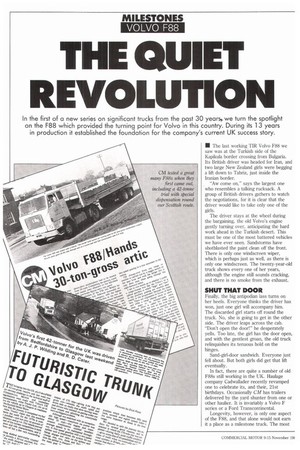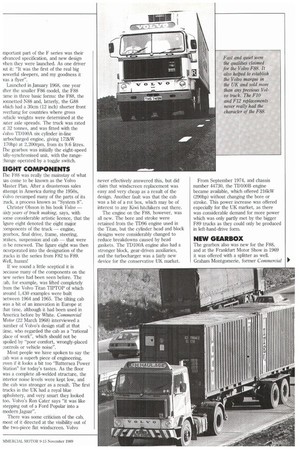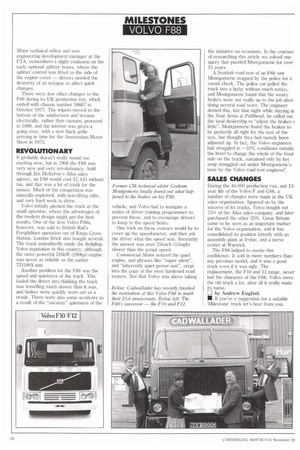THE QUIET REVOLUTION
Page 28

Page 29

Page 30

If you've noticed an error in this article please click here to report it so we can fix it.
In the first of a new series on significant trucks from the past 30 years, we turn the spotlight on the F88 which provided the turning point for Volvo in this country. During its 13 years in production it established the foundation for the company's current UK success story.
• The last working TIR Volvo F88 we saw was at the Turkish side of the Kapikula border crossing from Bulgaria. Its British driver was headed for Iran, and two large New Zealand girls were begging a lift down to Tabriz, just inside the Iranian border.
"Aw come on," says the largest one who resembles a talking rucksack. A group of British drivers gathers to watch the negotiations, for it is clear that the driver would like to take only one of the girls.
The driver stays at the wheel during the bargaining, the old Volvo's engine gently turning over, anticipating the hard work ahead in the Turkish desert. This must be one of the most battered vehicles we have ever seen. Sandstorms have shotblasted the paint clean off the front. There is only one windscreen wiper, which is perhaps just as well, as there is only one windscreen. The twenty-year-old truck shows every one of her years, although the engine still sounds cracking, and there is no smoke from the exhaust.
SHUT THAT DOOR
Finally, the big antipodian lass turns on her heels. Everyone thinks the driver has won, just one girl will accompany him. The discarded girl starts off round the truck. No, she is going to get in the other side. The driver leaps across the cab. "Don't open the door!" he desperately yells. Too late, the girl has the door open, and with the gentlest groan, the old truck relinquishes its tenuous hold on the hinges.
Sand-girl-door sandwich. Everyone just fell about. But both girls did get that lift eventually.
In fact, there are quite a number of old F88s still working in the UK. Haulage company Cadwallader recently revamped one to celebrate its, and their, 21st birthdays. Occasionally CM has trailers delivered by the yard shunter from one or other haulier. It is invariably a Volvo F series or a Ford Transcontinental.
Longevity, however, is only one aspect of the F88, and that alone would not earn it a place as a milestone truck. The most mportant part of the F series was their idvanced specification, and new design when they were launched. As one driver iut it: "It was the first of the real big iowerful sleepers, and my goodness it vas a flyer".
Launched in January 1968, one year ifter the smaller F86 model, the F88 :ame in three basic forms: the F88, the ionnetted N88 and, latterly, the G88 which had a 30cm (12 inch) shorter front werhang for countries where gross 'elide weights were determined at the niter axle spreads. The truck was rated it 32 tonnes, and was fitted with the Volvo 'I1)100A six cylinder in-Line .urbocharged engine, giving 172kW ;170hp) at 2,200rpm, from its 9,6 litres. The gearbox was initially the eight-speed iilly-synchronised unit, with the range:hange operated by a toggle switch.
EIGHT COMPONENTS
The F88 was really the mainstay of what as come to be known as the Volvo Vlaster Plan. After a disasterous sales fttempt in America during the 1950s, Volvo revamped many of the parts of its :ruck, a process known as "System 8".
Christer Olsson in his book Volvo — ;ixty years of truck making, says, with some considerable artistic licence, that the igure eight denoted the eight major components of the truck — engine, gearbox, final drive, frame, steering, rakes, suspension and cab — that were xi be renewed. The figure eight was then incorporated into the designation of the trucks in the series from F82 to F89.
humm!
If we sound a little sceptical it is necause many of the components on the aew series had been seen before. The cab, for example, was lifted completely from the Volvo Titan TIPTOP of which round 1,430 examples were built between 1964 and 1965. The tilting cab was a bit of an innovation in Europe at :hat time, although it had been used in America before by White. Commercial Motor (22 March 1968) interviewed a number of Volvo's design staff at that \ time, who regarded the cab as a "rational place of work", which should not be spoiled by "poor comfort, wrongly-placed controls or vehicle noise".
Most people we have spoken to say the cab was a superb piece of engineering, even if it looks a bit too "Battersea Power Station" for today's tastes. As the floor was a complete all-welded structure, the interior noise levels were kept low, and the cab was stronger as a result. The first trucks in the UK had a royal blue upholstery, and very smart they looked too. Volvo's Ron Cater says "it was like stepping out of a Ford Popular into a modern Jaguar".
There was some criticism of the cab, most of it directed at the visibility out of the two-piece flat windscreen. Volvo
never effectively answered this, but did claim that windscreen replacement was easy and very cheap as a result of the design. Another fault was that the cab was a bit of a rot box, which may be of interest to any Kiwi hitchikers out there.
The engine on the F88, however, was all new. The bore and stroke were retained from the TD96 engine used in the Titan, but the cylinder head and block designs were considerably changed to reduce breakdowns caused by head gaskets. The TD100A engine also had a stronger block, gear-driven auxiliaries, and the turbocharger was a fairly new device for the conservative UK market. From September 1974, and chassis number 44730, the TD100B engine became available, which offered 216kW (290hp) without changing the bore or stroke. This power increase was offered especially for the UK market, as there was considerable demand for more power which was only partly met by the bigger F89 trucks as they could only be produced in left-hand-drive form.
NEW GEARBOX
The gearbox also was new for the F88, and at the Frankfurt Motor Show in 1969 it was offered with a splitter as well. Graham Montgomerie, former Commercial
Motor technical editor and now
engineering development manager at the ETA, remembers a slight confusion on the early optional splitter boxes, where the splitter control was fitted to the side of the engine cover — drivers needed the dexterity of an octopus to affect quick changes.
There were few other changes to the F88 during its UK production run, which ended with chassis number 58667 in October 1977. The wipers moved to the bottom of the windscreen and became electrically, rather than vacuum, powered in 1969, and the interior was given a going over, with a new black grille arriving in time for the Amsterdam Motor Show in 1973.
REVOLUTIONARY
It probably doesn't really sound too exciting now, but in 1968 the F88 was very new and very revolutionary. Sold through Jim McKelvie's Ailsa sales agency, an F88 would cost £7,443 without tax, and that was a lot of truck for the money. Much of the competition was naturally-aspirated, with non-tilting cabs, and very hard work to drive.
Volvo initially pitched the truck at the small operator, where the advantages of the modern design might get the best results. One of the first Volvo F88s, however, was sold to British Rail's Freightliner operation out of Kings Cross Station. London Brick also bought several. The truck undoubtedly made the fledgling Volvo reputation in this country, although the more powerful 216kW (290hp) engine was never as reliable as the earlier TD100A unit.
Another problem for the F88 was the speed and quietness of the truck. This fooled the driver into thinking the truck was travelling much slower than it was, and brakes were quickly worn out as a result. There were also some accidents as a result of the "uncanny" quietness of the
Former CM technical editor Graham Montgomerie finally found out what happened to the brakes on his F88.
vehicle, and Volvo had to instigate a series of driver training programmes to prevent these, and to encourage drivers to keep to the speed limits.
One trick on these courses would be to cover up the speedometer, and then ask the driver what the speed was. Invariably the answer was over 25km/h (15mph) slower than the actual speed.
Commercial Motor noticed the quiet engine, and phrases like "super silent", and "inherently quiet power unit", crept into the copy of the most hardened road testers. Not that Volvo was above taking Below: Cadwallader has recently finished the restoration of this Volvo F88 to mark their 21st anniversary. Below left: The F88's successor — the F10 and F12. the initiative on occasions. In the courses of researching this article we solved one query that puzzled Montgomerie for over 15 years.
A Scottish road test of an F88 saw Montgomerie stopped by the police for a casual check. The police car pulled the truck into a layby without much notice, and Montgomerie found that the weary brakes were not really up to the job after doing several road tests. The engineer denied this, but that night while staying in the Stair Arms at Pathhead, he called out the local dealership to "adjust the brakes 2 little". Montgomerie found the brakes to be perfectly all right for the rest of the test, but thought they had merely been adjusted up. In fact, the Volvo engineers had struggled in –10°C conditions outside the hotel to change the whole of the front axle on the truck, sustained only by hot soup smuggled out under Montgomerie's nose by the Volvo road test engineer!
SALES CHANGES
During the 40,000 production run, and 13year life of the Volvo F and G88, a number of changes were made in the UK sales organisation. Spurred on by the success of its trucks, Volvo bought out 75% of the Ailsa sales company, and later purchased the other 25%. Great Britain came to be seen as an important market for the Volvo organisation, and it has consolidated its position latterly with an assembly plant at Irvine, and a nerve centre at Warwick.
The F88 helped to create this confidence. It sold in more numbers than any previous model, and it was a good truck even if it was ugly. The replacement, the FIO and 12 range, never had the character of the F88. Volvo owes the old truck a lot, after all it really made its name.
by Andrew English • If you've a suggestion for a suitable 'Milestone' truck let's hear from you.




























































































































